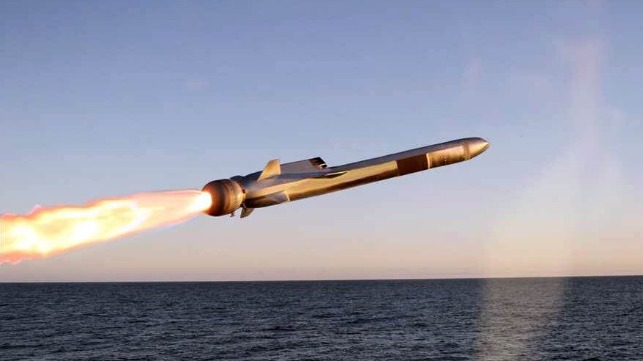Royal Navy Signs Up for Naval Strike Missile to Replace Harpoon

The UK Ministry of Defence has reached a deal to replace the aging Harpoon anti-ship missiles on 11 of its warships with the smaller but more advanced Naval Strike Missile (NSM).
The NSM is a subsonic cruise missile with a range of 100-plus nautical miles and a 275-pound explosive warhead. It is built by Kongsberg and used by the Royal Norwegian Navy, the Polish military (in a coastal-defense role), the U.S. Navy's Littoral Combat Ship and Constellation-class frigate programs, and the U.S. Marine Corps' NMESIS unmanned-mobile-launch truck. It has multiple future orders from a wide variety of international operators. NSM is able to identify and distinguish targets on its own using an infrared camera and an onboard database of target descriptions.
The Harpoon is a Cold War-era subsonic cruise missile with a larger 500-pound warhead and shorter 75 nm range. It is a ubiquitous device found in service with U.S.-allied operators around the world, from Canada to Australia to Ukraine, where it is used to keep Russian Navy assets away from Odesa. On June 17, a Harpoon was reportedly used to sink the Russian tug Spasatel Vasily Bekh, which was carrying a Tor air-defense system and was under way to reinforce Russian positions on occupied Snake Island.
As a sign of its continued utility in certain applications, a submarine-launched version of Harpoon that was retired from U.S. Navy service in the 1990s is now being refurbished and reintroduced to the Los Angeles-class attack sub fleet.
However, Harpoon is showing its age. In the coming year, eleven Royal Navy Type 23 frigates and Type 45 destroyers will be retrofitted with the lighter NSM. The MOD ordered the missile system as an interim replacement for its Harpoons, which reach the end of their service life next year.
UK Defence Secretary Ben Wallace announced the investment in the new weapon on a visit to Royal Navy flagship HMS Queen Elizabeth in the Norwegian capital of Oslo, not far from Kongsberg's headquarters.
The Royal Navy believes that despite upgrades and enhancements to Harpoon, it cannot meet the demands of modern naval warfare. NSM will fill in temporarily while the UK works on procuring a "future offensive surface weapon" - a heavyweight antiship / land-attack missile scheduled for a 2028 delivery.

that matters most
Get the latest maritime news delivered to your inbox daily.
Babcock and BAE hold the installation contract for NSM, and the first ship should be ready and retrofitted by the end of next year.
When they have been replaced, the UK's Harpoons could well end up in the Ukrainian inventory, joining compatible missiles and coastal-battery launchers from Denmark, the Netherlands and the United States.
